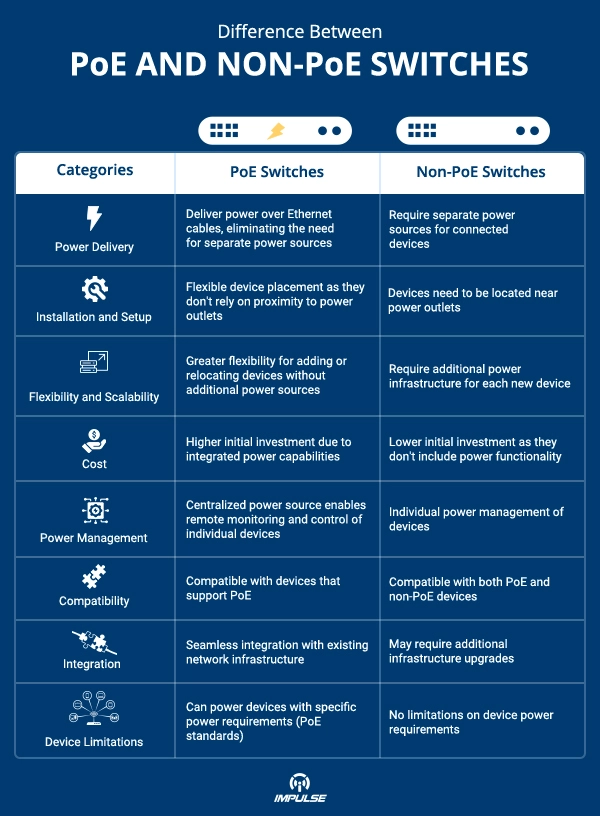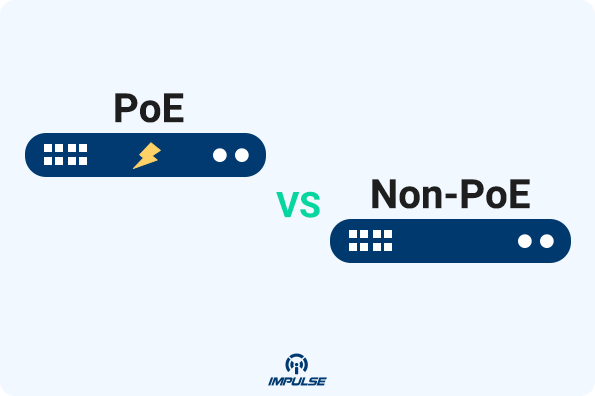1. Introduction to POE and Non-POE Network Switches
Power over Ethernet (POE) network switch and Non-POE network switches are two fundamental components of modern network infrastructure, each with its own set of benefits and considerations. Understanding the difference between these two types of switches is crucial for IT professionals and network administrators. POE network switches provide power and data connectivity over a single Ethernet cable, simplifying installation and reducing costs. On the other hand, Non-POE network switches require separate power sources for devices. This article aims to explore the disparities between POE and Non-POE switches, highlighting their features, advantages, and considerations to help you make informed decisions when selecting the most suitable switch for your network requirements.
1.1 What are POE and Non-POE Network Switches?
POE stands for Power over Ethernet, which is a technology that allows both power and data to be transmitted over standard Ethernet cables. This means that devices like IP cameras, wireless access points, and VoIP phones can be powered directly from the network switch, eliminating the need for separate power cables. Non-POE network switches, on the other hand, do not have this capability and require devices to be powered by separate power adapters.
1.2 Importance of Understanding the Difference
Understanding the difference between POE switch and non-POE switch is crucial when designing and setting up a network infrastructure. It affects the choice of devices, power requirements, and overall flexibility of the network. By knowing the distinction, you can make informed decisions and ensure that your network meets the specific needs of your applications.
2. Understanding Power over Ethernet (POE)
2.1 Definition and Functionality of POE
POE is a technology that allows electrical power to be transmitted over Ethernet cables along with data signals. It simplifies the installation process by eliminating the need for separate power sources for network devices. With POE, you can power devices in remote locations without the limitations of power outlets.
2.2 POE Standards (802.3af, 802.3at, etc.)
There are different POE standards, the most commonly used being 802.3af (POE) and 802.3at (POE+). These standards define the maximum power that can be delivered over Ethernet cables. POE provides up to 15.4 watts of power per port, while POE+ can deliver up to 30 watts. Some devices, like high-power IP cameras or wireless access points, may require the higher power capabilities of POE+.
2.3 How POE Works in Network Infrastructure
POE (Power over Ethernet) works by utilizing the unused wires in an Ethernet cable to deliver electrical power. The power sourcing equipment (PSE), typically a POE switch, injects power into the cable, while the powered device (PD) consumes the power. This technology enables the simultaneous transmission of both power and data over a single Ethernet cable, eliminating the need for separate power sources for network devices. POE is widely used in various applications, including network switches and industrial Ethernet switches, due to its ability to simplify installations and provide power flexibility.
POE switches can simplify network deployments in outdoor environments? With the ability to power devices remotely, POE switches eliminate the need for separate power outlets and make it easier to install and maintain network equipment in outdoor settings like parking lots, stadiums, and public spaces.
3. Exploring Non-POE Switches
3.1 Features and Functionality of Non-POE Switches
Non-POE switches are traditional network switches that do not have the built-in capability to deliver power over Ethernet cables. They are typically used in environments where POE is not required or in conjunction with separate power sources for devices. These switches are commonly used in conjunction with industrial Ethernet switches to create a comprehensive network infrastructure.
3.2 Traditional Power Supply for Non-POE Switches
Non-POE network switches are powered through a traditional AC power outlet using power adapters or power supply units. Each device connected to the switch requires its own power source, which can result in a more complex and less flexible setup compared to POE network switches. However, with the use of POE injectors, it is possible to add POE functionality to non-POE switches, providing a solution for powering networking devices in scenarios where POE is required.
4. Key Differences between POE and Non-POE Switches
4.1 Power Delivery Capability
The main difference between POE network switches and non-POE network switches is the power delivery capability. POE network switches can deliver power over Ethernet cables, simplifying the installation and reducing the need for separate power sources. This is particularly beneficial for network switches, industrial Ethernet switches, and other POE network devices that require both power and data connectivity. On the other hand, non-POE switches require devices to be individually powered using separate power adapters, which can lead to a more cluttered setup.
4.2 Installation and Setup Requirements
POE network switches offer more flexibility in device placement since they do not rely on the proximity to power outlets. This makes them ideal for installations in remote or hard-to-reach areas, such as outdoor environments where power availability may be limited. In contrast, non-POE switches require devices to be located near power outlets, which can restrict their placement options.
4.3 Flexibility and Scalability
POE network switches provide greater flexibility and scalability compared to non-POE network switches. With POE, devices can be easily added or relocated without the need for additional power sources, making network expansion simpler and more cost-effective. This is especially advantageous for environments that require frequent changes in device placement or have plans for future growth. Non-POE switches, on the other hand, require additional power infrastructure for each new device, which can be time-consuming and costly in larger networks.

5. Advantages of POE Switches
5.1 Simplified Installation and Reduced Costs
POE network switches offer a simplified installation process that saves you both time and money. With traditional switches, you need to run separate power cables alongside the Ethernet cables to power your network devices. However, with POE network switches, power is delivered through the same Ethernet cables that are used for data transmission. This eliminates the need for additional power outlets and reduces installation costs.
5.2 Increased Flexibility in Device Placement
POE network switches provide greater flexibility in device placement. Since they do not require proximity to power outlets, you can easily place your network devices wherever they are needed, even in areas without nearby power sources. This flexibility allows for more efficient network deployment and reduces the limitations imposed by power availability. Industrial Ethernet switches are often deployed in harsh environments where power outlets may not be readily available, making POE an ideal solution.
5.3 Enhanced Network Management and Control
POE network switches offer enhanced network management and control capabilities. Through the use of a centralized power source, you can remotely monitor and control the power consumption of individual devices. This feature enables better energy management and allows for troubleshooting and power cycling without physically accessing each device. Networking devices powered by POE can be easily managed and controlled, making network maintenance and operations more efficient.
Look no further! Impulse CCTV is a leading manufacturer of reliable and high-quality POE network switches in India. With expertise in network infrastructure and power over Ethernet technology, we offer ideal solutions for various applications, including surveillance systems, wireless access points, and industrial environments.
6. Advantages of Non-POE Switches
6.1 Lower Initial Investment and Equipment Costs
If you’re looking to save some bucks upfront, non-POE switches might be the way to go. They generally come with a lower price tag compared to their POE counterparts. Non-POE switches are a budget-friendly option, especially when you don’t anticipate needing POE capabilities for all your network devices. Industrial environments, in particular, can benefit from the cost savings provided by non-POE switches, especially when considering industrial Ethernet switch deployments.
6.2 Better Power Management Options
Non-POE switches offer better power management options. Unlike POE network switches that supply power to all connected devices simultaneously, non-POE switches allow you to individually manage the power supply to each device. This can be particularly useful in scenarios where you want to optimize power consumption or prioritize critical devices over others. By having finer control over power allocation, you can ensure efficient power management in your network.
6.3 Compatibility with Legacy Devices
If you have older network devices that rely on separate power sources, non-POE switches are your go-to option. These switches are fully compatible with legacy devices that do not support POE. So, unless you’re planning to replace all your existing network equipment, non-POE switches offer seamless integration with your current setup. This compatibility makes non-POE switches an attractive option for organizations with a mix of legacy and modern network devices.
7. Considerations when Choosing between POE and Non-POE Network Switches
7.1 Power Requirements of Network Devices
Before making a decision, consider the power requirements of your network devices. If most of your devices support POE, opting for a POE network switch makes sense. On the other hand, if your devices do not require POE and you have a mix of POE and non-POE devices, a non-POE switch will suffice. This consideration helps ensure that you choose the right switch to meet the power demands of your network devices.
7.2 Future Expansion and Scalability
Think about your network’s future growth and scalability. If you anticipate adding more network devices that require POE functionality, it might be wise to invest in a POE network switch from the start. This ensures that you have the power capacity and flexibility to accommodate future expansion without the need for additional infrastructure upgrades. Network switches with POE capabilities provide a scalable solution to support the increasing power demands of your network.
7.3 Integration with Existing Network Infrastructure
Consider how well the switch will integrate with your existing network infrastructure. If you already have non-POE switches in place and replacing all of them is not feasible, a non-POE switch would be the logical choice. However, if you’re starting from scratch or your current infrastructure allows for seamless integration, a POE switch can offer significant advantages. Industrial Ethernet switches that support POE can be seamlessly integrated into existing network setups to provide power and data connectivity in a single solution.
Also Read : Using PoE Switches for IP Surveillance: A Guide for Beginners
8. Conclusion and Recommendations
In conclusion, the choice between POE network switches and non-POE network switches depends on the specific needs and circumstances of your network. POE network switches offer convenience, cost savings, and flexibility in device placement, making them ideal for environments with multiple powered devices. Non-POE network switches, on the other hand, provide a more cost-effective solution for networks with fewer powered devices or when compatibility with legacy equipment is essential.
If you’re looking for reliable and high-quality network switches, consider POE network switches. With their integrated power capabilities, POE network switches simplify installation, reduce costs, and provide enhanced network management and control. They are suitable for a wide range of applications, including surveillance systems, wireless access points, and industrial environments.
Impulse CCTV, a leading manufacturer of POE network switches in India, offers ideal solutions for various network requirements. Their expertise in network infrastructure and power over Ethernet technology ensures reliable and efficient performance.
By emphasizing the benefits of POE network switches and highlighting their advantages in terms of simplified installation, reduced costs, increased flexibility, and enhanced network management, you can make an informed decision to invest in a POE switch that best aligns with your network needs. Upgrade your network infrastructure with POE switches and experience the convenience and efficiency they bring to your network.
Experience simplified installation, reduced costs, and enhanced network management with our top-of-the-line POE network switches. Stay ahead of the game by upgrading to POE network switches from Impulse CCTV.


